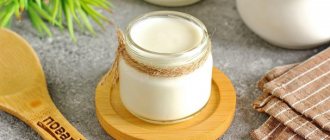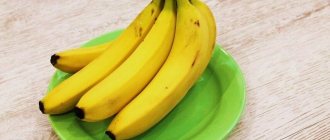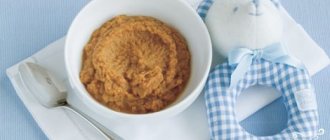We prepare baby cottage cheese at home.
1. prepare cottage cheese from milk.
For 1 liter of milk you need to take 1 tablespoon of lactic acid starter. You can buy milky sourdough starter at a dairy kitchen or take 1 - 1.5 tablespoons of sour cream instead. In a dairy kitchen, sourdough is very delicate, but sour cream also makes good cottage cheese. Pour the starter into the milk, stir, cover with gauze and leave until morning at room temperature.
The next day, the milk will turn into curdled milk, which must be poured into a saucepan, put on low heat and brought to a boil.
As the sour milk heats up, the curd flakes will begin to separate from the whey. They can be collected with a spoon with holes and placed in a colander lined with gauze in 1 - 2 layers. There is no need to bring the milk to a strong boil, otherwise the cottage cheese will become too cool and the flakes will become very small.
Place all the curd in a colander and let stand for a few minutes until the whey drains completely.
The yield of cottage cheese when prepared at home is approximately 20% of the volume of milk; that is, to prepare 200 g of cottage cheese, you need to take 1 liter of milk.
2. how to prepare cottage cheese for a child from kefir?
It’s not difficult to prepare cottage cheese from kefir for children; all you need is a couple of saucepans, a strainer and the kefir itself. The amount of the latter will have to be determined independently, given that from 600 grams of kefir (you need children's kefir) you get about 100 grams of cottage cheese.
As mentioned above, we will cook cottage cheese for the child using 2 pans in a water bath. In a large saucepan, bring water to a boil, then place the pan with kefir there and reduce the heat to medium. Carefully move the kefir from the edges to the center, no need to stir in a circle. After 10 minutes, when the kefir heats up to 60°C, remove both pans from the heat, leaving them in this state for 30-40 minutes. Next, drain the hot water, pour in cold water and place the pan with kefir there for 20 minutes. When the kefir has cooled, pour it into a strainer and let the whey drain. Afterwards, cool the cottage cheese.
The curd turns out to be a little sour, not all children like this taste. How to make cottage cheese more attractive to a child? It’s quite simple - add fruit to the curd, for example, mix an apple with curd in a blender. You can add fructose to cottage cheese, but not sugar. Although it is better for the baby to eat cottage cheese without any additives.
3. how to make calcined cottage cheese for babies?
Sometimes, on the recommendation of a pediatrician, it is necessary to make calcined cottage cheese for children. It is usually introduced into the diet when the baby’s fontanelle does not close well and the body requires additional calcium. Calcined cottage cheese is also prescribed to children with rapid tooth growth. But such cottage cheese should not be given to a child without the advice of a doctor.
To prepare calcined cottage cheese, you will need to purchase calcium chloride (in ampoules. The principle of preparing calcined cottage cheese is the same as in the previous recipe, only instead of lemon juice you need to take calcium chloride - 1 tablespoon per 600 ml of milk. Of course, such cottage cheese is healthier, but , for my taste, it is slightly bitter.
You need to remember that you should not give your child a large amount of cottage cheese at once. The first time the serving should be no more than 1 teaspoon. Also, for the first experiment, it is better not to add anything to the cottage cheese. Later, when cottage cheese becomes part of the diet and/or the baby begins to be capricious, you can gradually add fruit to the cottage cheese. But even in this case, it is better to alternate such cottage cheese with cottage cheese without any additives. Grow up healthy!
Introduction to diet
- You can’t introduce cottage cheese to a baby’s menu before six months; before that time, the baby’s intestines are too weak to cope with the heavy fermented milk product, and the kidneys are not ready to withstand the load from nitrogen compounds that appear when proteins are processed. For the same reason, you cannot rush things and arbitrarily increase the amount of cottage cheese in your baby’s diet.
- As a rule, pediatricians recommend starting to give cottage cheese to babies at 7.5-8 months, when the child successfully accepts cereals, vegetables and fruits. Often, specialists “postpone” the baby’s introduction to the product by first introducing meat and fish into its menu. In special cases, cottage cheese is “ahead” of other types of complementary foods, for example, when the baby has developed rickets or is not gaining weight well.
- Cottage cheese for children under one year of age should be given gradually - from half a teaspoon, gradually increasing the volume by the same amount. In the first month, the baby should eat no more than 30 grams (3 teaspoons) per day, in the second month of introducing complementary foods - 40 grams, and a one-year-old child can already eat 50 grams of cottage cheese. The baby should eat exactly the amount of product required according to the norm for introducing this complementary food; exceeding it can overload his kidneys.
- In order to have time to track negative reactions, stop complementary feeding and do everything necessary to relieve allergies, introduce the product in the first half of the day.
- You need to give your child cottage cheese at the beginning of a meal, and then supplement it with the type of food that is more familiar to the baby - milk or formula. For a one-year-old baby, you can already mix the product with fruit puree.
Children's cottage cheese at home. Children's cottage cheese
Dear forum users, I bring to your attention a homemade cottage cheese, ideal for baby food. This topic is just relevant for me now - I’m starting to introduce cottage cheese into complementary foods. Here in Europe, as you know, there are no dairy kitchens, so I will make cottage cheese, as well as other fermented milk products, myself. I don’t trust store-bought ones, and they are stored on store shelves (not in the refrigerator). So, Children's cottage cheese
Step-by-step recipe with photos
Pour a glass of milk into a saucepan, put on fire, and bring to a boil. Pour in kefir and immediately turn off the stove. Stir until the curd begins to separate from the whey. Remove from the stove and cool.
Pour the resulting mass into a sieve previously lined with gauze (if the sieve is small, you can do without gauze). Taking the ends of the gauze, squeeze out the excess liquid.
If allergy
An allergy to cottage cheese in an infant can be a serious challenge for parents. Like any food allergic reaction, it can manifest itself as peeling of the skin of the face and hands, the appearance of red spots and pimples. In the most difficult cases, swelling may occur in the area of the lips and tongue; swelling can spread to the internal organs of the respiratory system, making it difficult for the baby to breathe.
It is strictly not recommended to introduce cottage cheese into a child’s diet before 6 months. Protein foods, on the one hand, are a difficult test for the stomach (bloating, increased gas formation, and vomiting may occur), on the other hand, animal protein is one of the most powerful food allergens. If you have to introduce cottage cheese for medical reasons, it makes sense to consult a pediatrician and allergist about the dosage of the product. Only soft cottage cheese with a delicate consistency is suitable for feeding children.
Cottage cheese for children under one year old at home. Prepare the product at home
Parents often ask the question: “What kind of cottage cheese can be given to a baby at 6 months?” The store-bought product contains chemical preservatives, cheap milk fat, various fruit fillers, and sugar. Don’t risk your baby’s health and prepare the dairy product yourself.
Homemade cottage cheese for babies can be prepared in various ways. This product is perishable; store in the refrigerator (no more than 3 days).
Recipe 1
Products:
- 200 ml milk;
- 3-4 tbsp. spoons of curdled milk (can be replaced with sour cream).
Boil the milk and cool to 40-50 degrees. Add sour cream to it, stir until smooth. Cover the pan with a lid and wrap tightly with a towel, place in a warm place overnight. In the morning the contents will turn into thick kefir. Boil it and immediately remove from heat. Pass the thickened mass with separated whey through a sieve. This pureed tender cottage cheese is ideal for a 7 month old baby.
Recipe 2
To prepare, you need to purchase 1 sachet of 1% kefir. Without opening the bag, place it in the freezer. In the morning, remove the frozen product from the cold, open it and transfer it to a sieve, previously covered with clean gauze. As it melts, the whey will gradually begin to drain, and a delicate curd mass will remain in the gauze, in which all the beneficial bacteria will be preserved.
Recipe 3
What will you need?
- 300 ml milk.
- Calcium chloride solution (sold at the pharmacy).
For reference! This recipe is used to prepare cottage cheese for children under one year of age whose body does not have enough calcium. Before starting use, it is advisable to obtain permission from your pediatrician.
The milk needs to be boiled and cooled. Then add a solution of calcium chloride, at the rate of 1 ml of solution per 100 ml of milk. Next, mix thoroughly and bring to a boil, but make sure that it does not start to boil.
The resulting mixture should be placed in a colander previously lined with gauze. When most of the whey (but not all) has drained, the finished cottage cheese can be rubbed through a sieve to obtain a uniform consistency. The cottage cheese should not be thick.
Norms for the consumption of cottage cheese by children
According to pediatricians, you can start giving cottage cheese at 8 months. Like any other complementary food, it is given a little at a time, observing the reaction of the baby’s body. The portion is gradually increased, and by 9 months it reaches 30 grams, at 10 months. – 40 years, by the year – 50 years.
Even combining formula to supplement your baby's diet with some breast milk will do wonders for your baby's development and overall health. No commercial formula will ever come close to the quality of breast milk!
If you have no alternative but to feed your baby's form, add good quality probiotics to each feeder from the start. Mastitis is an integral part of breastfeeding. Most breastfeeding women get this more than once. If a mother gets mastitis, the last thing she should do is stop breastfeeding! Continue to feed your baby on sore breasts as it will benefit both you and your baby. For you: regular breast emptying is a necessary treatment for mastitis; you should not allow milk to stagnate in your breasts.
How to make baby curd with lemon. If you add lemon juice
The method of preparing homemade cottage cheese does not exclude the use of other products to obtain it. To prepare cottage cheese at home, the recipe for which contains lemon, you do not need any complex culinary equipment. The milk is placed on low heat; as soon as it begins to boil, lemon juice is immediately added to it. After this, the milk will instantly curdle, so turn off the heat immediately.
The milk cools down and is filtered in the same way as to obtain the product according to previous recipes. To make cottage cheese using lemon, you will need the juice of half a citrus fruit per 1 liter of milk. But the answer to the question of how to make baked goods with such a delicious fermented milk product, alas, will turn out to be negative. The recipe for making cottage cheese with lemon makes the dairy product very soft and has a pleasant taste. But it is absolutely not suitable for baking.
How to make cottage cheese for food lovers? For gourmands, there is a more complex classic recipe that requires only milk. How to make such cottage cheese? It’s also quite simple, the main thing is to have a little patience. Natural milk sours for more than a day at average room temperature. If you don’t know how to make yogurt, here is the recipe.
The sour milk is placed on low heat, heated, but not boiled. Under no circumstances should the curdled milk be stirred at this time. Then turn off the fire and leave the pan in a warm room for half a day. The whey is separated from the curd and becomes transparent. Here is the answer to the question of how to make whey from homemade milk, which is not only healthy, but also very popular in cooking. The cottage cheese is laid out in gauze folded in several layers. It is stored without losing its beneficial and taste qualities for up to 5 days.
What can be prepared from cottage cheese
Curd dishes are very varied. These can be pies, cheesecakes, rolls, casseroles, muffins, dumplings and many other healthy and tasty snacks and desserts. Cottage cheese is a universal product that can be used to prepare breakfast or baked goods for evening tea. Any cottage cheese dish can be decorated using fruits, berries and nuts, which will provide additional nutrition and benefit. The usual list of cottage cheese dishes can be diversified by preparing cottage cheese dumplings, paskas, pudding, oatmeal cookies and cottage cheese.
Homemade children's cottage cheese. How to make baby cottage cheese
It is very easy to make baby cottage cheese at home. And such a dish, made by mother’s hands, will be doubly healthier for the baby than one bought in a store.
Choose your recipe
1
To ultimately obtain 100 grams of curd, take 150-200 ml of fresh milk. If the child is very small, then it is better to boil the milk first and let it cool a little. Unboiled food should be slightly heated in a microwave oven or over a fire.
2
Take a small glass jar, wash it thoroughly and put two tablespoons of sour cream on the bottom. To make the cottage cheese more tender and soft, you need to choose sour cream with less fat content. The best option is 20 percent.
3
Pour the prepared milk into the sour cream in a ratio of 1:3. Without stirring, put the jar in a warm place for 10-12 hours. In winter, you can place the container directly on the battery. In summer, it takes less time for milk to coagulate - 5-6 hours.
4
Wait for the milk to curdle and thicken. The resulting mass should be placed directly in the jar in a small saucepan to cook in a water bath. It is necessary that the water in which your curd will languish should be slightly more than the consistency in the jar. Cooking time is one hour. When the curd mass in the jar settles and a cloudy broth forms on the surface, it’s time to turn off the gas.
5
Remove the jar from the pan and let cool slightly. Do not wait for the curd mass to cool completely, otherwise the curd will be hard. Then strain through a sieve or cheesecloth, draining all unnecessary water. Lightly sprinkle the curd with sugar. He's ready.
note
Children's cottage cheese can be made from baby fruit puree or mother's milk.
Helpful advice
If the child does not eat cottage cheese, add some fruit puree. This way the curd will acquire a more interesting taste and your baby will definitely like it.
Cheesecakes with cottage cheese made from puff pastry
This recipe will not take much time and will be an excellent option for a snack or tea party. For baking, it is better to use yeast-free dough, then the cheesecakes will be crispy. You will need to mix cottage cheese, egg and sugar, you can use a blender. The dough should be cut into even circles or into 10x10 cm squares. If you choose a circle shape, you can use the shape of a saucer, carefully cutting out a circle along the diameter. You need to cut out a side of the same diameter. So that the filling does not slide off the base when baking.. If you choose a square shape, then you can fold it in the form of a triangle, securing the edges by pressing the tines of a fork.. Place 1 tbsp on top of the dough. spoon of curd filling and brush the dough with beaten egg. Place the cheesecakes in a preheated oven and bake for 25 minutes at 180 C.
How to make miracle cottage cheese. Miracle curd
I am convinced that this is the recipe that many people have been looking forward to, right? And now it’s ready - homemade airy miracle curd! Anticipating the question “Is it really the same as a store-bought dessert?”, I will answer without cunning that it is about 90%. Homemade miracle cottage cheese turns out to be very tender, aromatic, moderately sweet and very tasty. Get ready: today I will write a lot and in detail, so be patient if you decide to repeat this dessert at home.
In general, I made the recipe a long time ago, but I still didn’t have the heavy cream to implement it. Having repeatedly studied the composition of the miracle curd, which is listed on the label, I took the basic ingredients as a basis and began to experiment. I prepared the dessert twice, and the first result was closer to the original, while the second turned out to be more like a delicate curd jelly.
A little more lyrics and let's move on to the ingredients, bear with us. You must understand that for this dessert it is important to use the freshest products, since the miracle curd will be ready only after 30-35 hours. It is during this time that some miraculous changes occur in it, thanks to which the curd mass becomes truly airy and porous. Don't rush things: push the dessert into the far corner of the refrigerator and forget about it for a while.
Well, now let’s take a closer look at the products that I used to make homemade miracle cottage cheese. Cottage cheese (we buy the freshest and not sour), I took 2% fat, although, in my opinion, absolutely any will do. And it doesn’t matter whether it’s pasty or dry - you still need to thoroughly beat it with a blender to achieve a completely homogeneous mass without grains. True, depending on the fat content and consistency of the cottage cheese (more on this in steps), the amount of liquid required, that is, milk, will depend.
Next, the miracle curd contains yogurt - as I understand it, it’s natural. I replaced it with sour cream, which is medium fat (I used 20%), as well as milk (I used 1.7% fat). But for the recipe for this homemade dessert you definitely need fat cream, that is, one that is suitable for whipping - at least 30% (in my case 32%).
We keep the amount of sugar as a sweetener to a minimum - I added literally a heaping tablespoon of it. The fact is that the cream itself is quite sweet, so you don’t need a lot of sugar. It’s up to you to add vanillin or not (it’s not included in store-bought miracle curds).
Now the key ingredient is gelatin. The texture of the finished dessert directly depends on its quantity, so it was important to calculate the mass so that the miracle curd turns out to be airy. As a result, I came to the conclusion that 1 teaspoon without (!) a slide, that is, under a knife, would be ideal. By the way, read on the label how many different stabilizers are used in the preparation of our favorite miracle. And we will only have gelatin!
And finally, about the filler. Here you have the right to choose the fruit and berry supplement that you personally like best. I used homemade cherry jam (originally cherry-cherry), although I also really love the kiwi-banana combination. You can also experiment with options: blueberry, strawberry-strawberry, peach-pear, peach-passion fruit, pineapple and chocolate. The choice is yours!
Nice to meet you: cottage cheese...
Everyone knows that protein products, of which cottage cheese is a representative, supply “building material” for the body’s cells. The fact is that when digested, any proteins break down into individual amino acids, which are the “building blocks” for the construction of the body’s own proteins. There are 20 known amino acids, ten of which are essential for the human body. This means that they cannot be synthesized in it and must be supplied with food. Of the essential amino acids, the rarest ones in terms of content in foods are methionine and tryptophan (they are necessary for the proper functioning of the nervous system, digestive tract and blood vessels). And it is cottage cheese that is the main source of these amino acids. In addition, it contains three more essential amino acids - histidine, phenylalanine and lysine. Cottage cheese is also rich in some vitamins - folic acid, B12, B6, B2, niacin. And of course, everyone knows that cottage cheese contains a lot of calcium and phosphorus. Moreover, the ratio of these two elements in cottage cheese is close to optimal for absorption and assimilation by the body. These minerals form the basis of bone tissue and teeth. That is why children need them during a period of active growth and development.
Children's cottage cheese, which is better. Children's cottage cheese
What is baby cottage cheese? How is it different from its adult counterpart? At what age can children be given cottage cheese? How is it useful? What is the best baby cottage cheese? The answer to all these questions worries all young mothers. The Roskontrol.rf portal will help you figure this out. Dairy products are very healthy for babies, and the more varieties there are in a child’s diet, the better. However, there is no need to rush - there are deadlines for introducing any new food into the baby’s menu. Most pediatricians recommend offering baby cottage cheese to your child when he or she is 8 months old. You need to start trying with a very small amount - one teaspoon. If no negative reaction occurs, the dose can be increased gradually. The benefits of children's cottage cheese are obvious: it is rich in vitamins, potassium and sodium salts, folic acid, lactic acid bacteria, it helps strengthen bones, and helps normalize digestion. It is worth noting that this product is absorbed better than kefir or yogurt. The highest demands are placed on the quality of children's cottage cheese. The packaging must state that the product is intended for use by children. Don't be fooled by the bright pictures and funny names. Only specialized baby products are suitable for babies. It is best to choose cottage cheese for a child, especially the first year of life, without any fruit additives or flavorings. Pay attention to the shelf life: the shorter it is, the more natural the baby cottage cheese is. Another important point is that the opened curd cannot be left for “next time.” If the child does not eat all the cottage cheese at once, the leftovers will have to be thrown away or eaten by themselves. The rating of children's products, as well as other important information, can be found in the Catalog on our website.
Cottage cheese for feeding babies
Regardless of when and where you start giving complementary foods, cottage cheese is always included in the baby’s diet. This product is very useful for the development of a small organism. It forms and strengthens the bone skeleton, ensures the growth of teeth and nails, stimulates brain function and improves memory.
Cottage cheese for a child under one year old is needed to stabilize the microflora and normalize the functioning of the intestines and liver. In addition, fermented milk products strengthen the immune system and protect against viral and infectious diseases.
Cottage cheese performs the following useful functions:
- Due to protein, it ensures full growth of muscle mass;
- Supplies bones with calcium, strengthens the bone skeleton;
- Reduces the risk of atherosclerosis;
- Normalizes digestion, helps with gastritis, ulcers and pancreatitis;
- Strengthens nerve cells;
- Develops memory and activates brain function;
- Strengthens immunity;
- Strengthens gums and tooth enamel;
- Tones the body, gives vigor and strength;
- Promotes the formation of new cells, which is very important for a child in the first year of life;
- Improves material metabolism;
- Has a beneficial effect on the condition of hair, nails and skin.
However, you shouldn’t get carried away with cottage cheese either. Always remember the dosage! It is not recommended to give cottage cheese to a child with excess calcium and kidney problems. In addition, some nutritionists see the danger of the product in its high potassium content. But in this case, you don’t have to worry, because breast milk contains approximately the same volume of the substance.
Porridge
Ingredients
The baby may not like porridge with cottage cheese for children, but if you don’t have any special prejudices, you can try it, because it’s very tasty!
- Oatmeal (rolled oats) - 2 tbsp. l.;
- Soft cottage cheese 5% - 100 g;
- Banana - 1 pc.;
- Sweetener - to taste;
- Coconut flakes - to taste.
Preparation
Mix oatmeal with cottage cheese and powdered sugar. Leave for 15 minutes. Peel and cut the banana into small slices. Add to the porridge, just like coconut flakes. A delicious and healthy breakfast is ready.
Cottage cheese candies: tasty and healthy
What to cook from cottage cheese for a child? Candies! The dessert looks very appetizing and looks like little Rafaelkas. They take 15 minutes to prepare and taste like homemade cheesecakes. For the filling you can use raisins, nuts or fruits. They will taste better the next day, if, of course, they remain. You will need 300 grams of cottage cheese, 2 tablespoons of honey, 2 tablespoons of coconut flakes and 1 tablespoon of butter. Cocoa powder, sesame seeds, coconut flakes or chocolate are suitable as breading.
You must first pour boiling water over the raisins and let them brew for 5 minutes. Cottage cheese should be combined with butter, honey and shavings, mixed thoroughly and using a spoon to form balls the size of a walnut. Place the filling in the middle, and then roll the resulting ball in coconut flakes, grated chocolate or cocoa. Chopped nuts can also be used as a breading. The dessert is ready, now it needs to be placed in a cold place for a couple of hours.
Cheesecakes
Ingredients
Cheesecakes for children are a wonderful delicacy that is not so difficult to prepare at home from cottage cheese.
- Yeast 1.5 teaspoon;
- Milk - 180 ml;
- Oil - 4 tablespoons;
- Eggs - 4 pcs;
- Sugar - 6 tablespoons;
- Flour - 500 grams;
- Cottage cheese - 600 grams.
Preparation
Add 1.5 teaspoons of sugar to the yeast.
Pour milk (50 grams) into this gradually, stirring as you add it so that the yeast forms a paste. Pour 130 ml of milk and 50 ml of water into a container for working with dough. We also send sunflower oil, a pinch of salt, 4 tbsp. spoons of sugar and three eggs. Mix it all with a whisk until smooth. Add the sifted flour in parts, and mix after each part. Pour in the yeast. Then add the flour again, stirring so that it does not clump. Bring until smooth, then add flour again (there should be 500 grams in total). Now take a little more flour from the packet, sprinkle it on the table and dump out the dough to knead it. The dough should not stick to your hands, but it should be soft and tender.
Add a little olive or sunflower oil to the bottom of the container. Place the dough there, level it and cover with cling film. Leave in a warm place for 20 minutes.
Pass the cottage cheese through a sieve. Add 2 tablespoons of sugar (tablespoons), 1 egg and a whisper of salt. Stir until smooth. Knead the dough directly in the bowl and leave for another 30 minutes.
Grease a baking sheet with sunflower oil. Divide the dough into two parts. We divide one part into 6-8 parts. To do this, you need to roll the sausage and cut it into exactly as many pieces as you need. The larger the pieces, the larger the cheesecakes will be.
Take a piece of dough and fold the edges into the middle. Make a ball and place it on a baking sheet, leaving a large distance, as the cheesecake will increase in volume. Dip the glass in flour and make a hole in each ball for the cottage cheese. We deepen the middle with our fingers. Add the filling to these craters. Separate the yolk from the white and brush the dough with it for an appetizing color. Place the cheesecakes for 15 minutes near a warm place so that the dough can still rise. Preheat the oven to 180 degrees and bake the cheesecakes for 20-30 minutes. They can be safely offered to children over 2 years old.
No-bake cottage cheese dessert
Curd desserts can be prepared without baking. You will need soft cottage cheese, 10% fat sour cream, gelatin, sugar and fruit. Mix cottage cheese with sour cream until smooth, add honey and sugar to taste. First add a glass of hot water to the gelatin and leave for 10 minutes until completely dissolved. After the time has passed, pour it in a thin stream into the curd and sour cream mass and mix. For dessert you will need a cake pan, place fruits and berries on the bottom and fill it with liquid mixture, and then put it in the refrigerator for a couple of hours to harden. You can serve this curd dessert with a decoration in the form of a mint sprig or a pattern of sugar syrup.











